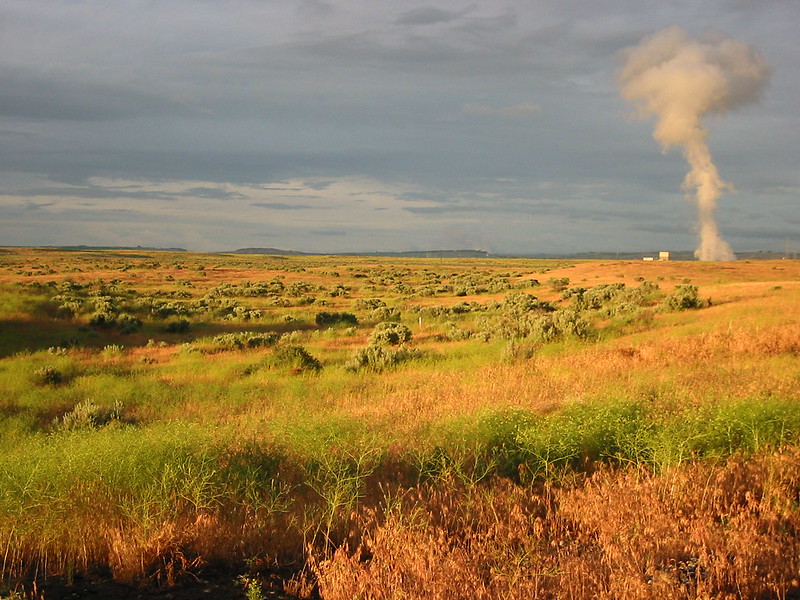Summarize this content to 2000 words in 6 paragraphs
Hanford Nuclear Reservation with Northwest Energy’s nuclear reactor letting off steam in the background. (Photo by Tobin, via Flickr, Creative Commons)
President Joe Biden this week issued one of his last executive orders, addressing the race to build domestic data centers and clean energy plants in order to retain America’s leadership in artificial intelligence.
“We will not let America be out-built when it comes to the technology that will define the future, nor should we sacrifice critical environmental standards and our shared efforts to protect clean air and clean water,” the order states.
The nation’s tech behemoths — including Seattle-area cloud giants Microsoft and Amazon — are sprinting to expand the computing power of their own AI operations and those of their cloud customers. But shortages of suitable land and clean energy are challenging these efforts.
Biden’s order directs the Department of Defense and the Department of Energy to “lease federal sites where the private sector can build frontier AI infrastructure at speed and scale” and highlights the essential role that AI plays in the economy and national security.
“As the land of liberty, America — not China — must lead the world in the development of AI,” Biden said in his farewell address to the nation on Wednesday evening.
The executive order calls on federal agencies to identify tracts for data centers and clean energy plants, and to work quickly in permitting the projects. It also emphasizes the need facilitate grid connections and electricity transmission, and points out next-gen nuclear and geothermal as potential power sources.
Amazon and Microsoft have been exploring some of these options. Amazon in October announced a deal that could lead to new small modular reactors built in central Washington and elsewhere. Both companies have agreements to either restart or tap into existing nuclear reactors.
The Biden administration was already exploring clean energy opportunities in Washington state before Tuesday’s order.
In July, the DOE announced it was negotiating with solar power provider Hecate Energy to create a deal to build up to 1 gigawatt of solar energy on the federally owned Hanford Nuclear Reservation near the state’s Tri-Cities. Portions of the site are undergoing a costly cleanup of nuclear weapons waste dating to World War II and the area is home to Washington’s only nuclear power utility.
Computer-packed data center facilities pose a specific construction challenge in that they need reliable power 24/7 and it needs to be clean to fulfill tech company pledges to eliminate their carbon emissions.
A shortage of available electricity is the limiting factor when it comes to data center projects, according to a report from CBRE. As energy access has declined, construction timelines have extended “two to four years and in some cases by as many as six years,” according to a 2023 study.
“Factors like permitting delays, interconnection challenges, and NIMBYism can impact the build out of both data centers and renewable energy projects,” Rob Collier, senior vice president of marketplaces for LevelTen Energy, a Seattle company that facilitates clean energy purchases, recently told GeekWire.
But data center deployments continue.
An analysis of capital expenditures by Amazon, Microsoft, Meta and Alphabet found the companies spent roughly $150 billion on construction and related costs in 2022 and 2023, but that number spiked to about $205 billion last year, according to a recent report from JLL. While the data didn’t tease out data center expenses alone, they’re believed to be driving the increase.
“Billions of dollars have been invested in AI over the last couple of years and all signals suggest that AI data center demand will continue to build momentum in 2025,” the JLL report states.
It’s getting harder to find spots for data center infrastructure in the Pacific Northwest, according the CBRE.
In Central Washington, “hyperscalers and data center developers continued to comb the region for suitable sites,” the August 2024 report states. “Data center owners are exploring alternative power sources, such as combinations of solar, batteries, wind and biofuels.”
In Northwest Oregon’s Hillsboro, demand for data center sites “remained robust, with a shortage of large available space blocks,” said the CBRE researchers.
RELATED: As AI booms, here’s how Microsoft and Amazon are coming up with energy solutions


